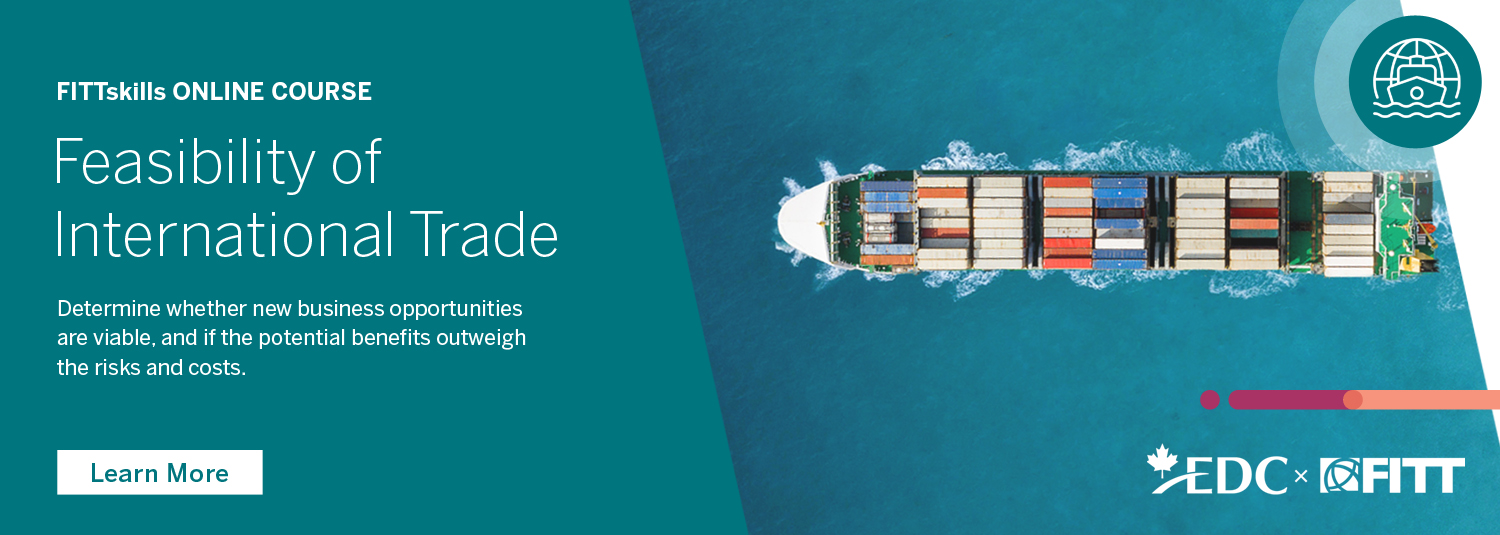
Before an organization embarks on a new initiative in international trade, it is important to assess the organization’s current conditions, attitudes and resources. The assessment needs to be made at all levels within the organization.
This first step is critical in the decision-making process and helps determine if the initiative is feasible, and if the potential gains and opportunities are worth the risk.
Part of assessing your organization’s readiness to expand into new markets is being proactive in identifying the downstream effects of launching a new initiative. Organizations need first to determine whether the initiative will affect the entire organization or only specific departments or groups.
Looking to determine if your new trade opportunities are viable? Check out the FITTskills Feasibility of International Trade online course!
If the change is small in scope and particular to a specific product line that is managed and operated as its own department in the current operation, the effect of the new initiative may be limited to that department and the senior management who will oversee the initiative.
However, if the initiative involves all of the products or services provided by the organization, it’s likely that every individual working for the organization will be impacted by the change in some way. Asking who in the organization will be impacted by the initiative should it move forward is crucial to adequately prepare and plan. For instance, if a department could be overwhelmed by the new customer demands, it may require additional human resources. This potential need must be accommodated in any planning the organization does before launching the initiative.
In addition to defining the impact internally, organizations should assess the impact the new initiative may have externally, such as on customers, clients, suppliers and partners.
Questions to ask include:
- Who are we currently doing business with that may be impacted by this initiative?
- Is it possible that resources will be shifted in such a way that existing customers/clients will be underserved?
- Will suppliers be able to keep up with the demand?
- Are business partners also willing and able to make the adaptations necessary to take on this change?
Addressing the gaps
If, after analyzing all of the factors above, an organization decides it needs to address some gaps before moving forward, it does not mean your plans for expansion can never move ahead.
Instead, a variety of avenues may fulfill the needs identified in the situational analysis. Depending on the particular gap, internal or external resources might be used to prepare the organization for the change it will undergo. If the gap identified is in the area of:
- Capacity of human resources: The organization may develop a plan to train existing employees and hire new staff.
- Cultural competency: The organization may develop and execute a training plan to improve its employees’ abilities to work with different cultures.
- Access to financial resources: The organization may approach governmental and non-governmental institutions and agencies to secure assistance, such as loans and insurance.
- Logistics resources: The organization may need to research and secure arrangements with third party suppliers such as freight forwarders or customs brokers.
Many organizations choose to access and/or hire third-party experts to help them prepare for new international ventures. Once an internal gap has been identified, experts in areas such as finance or cultural awareness can help ensure that the information organizations obtain is current and reflects good business practices.
A variety of programs and services address these needs. These include governmental agencies and their experts (such as export development agencies and trade commissioners), industry associations and their representatives, and third-party providers (such as training organizations, customs brokers and freight forwarders).
Many countries produce guides that list government programs and services available, such as the Exports Program Guide produced for American organizations by the U.S. Department of Commerce and International Trade Administration. Organizations looking to be proactive and adequately prepare for new international trade ventures should research and access the programs and services available in their region.






disqus comments